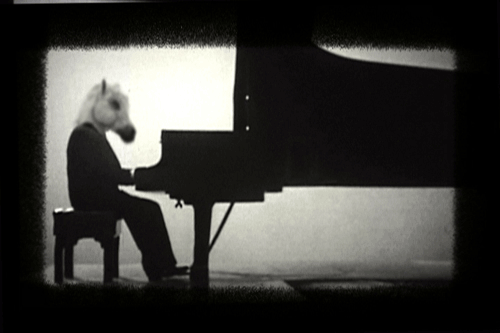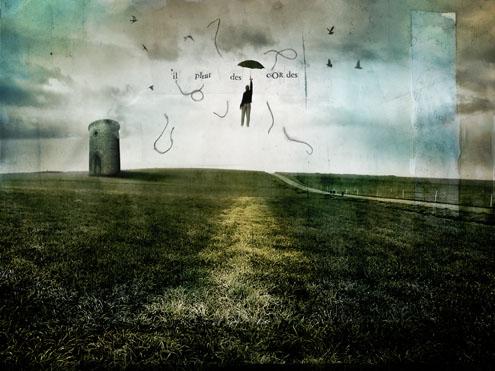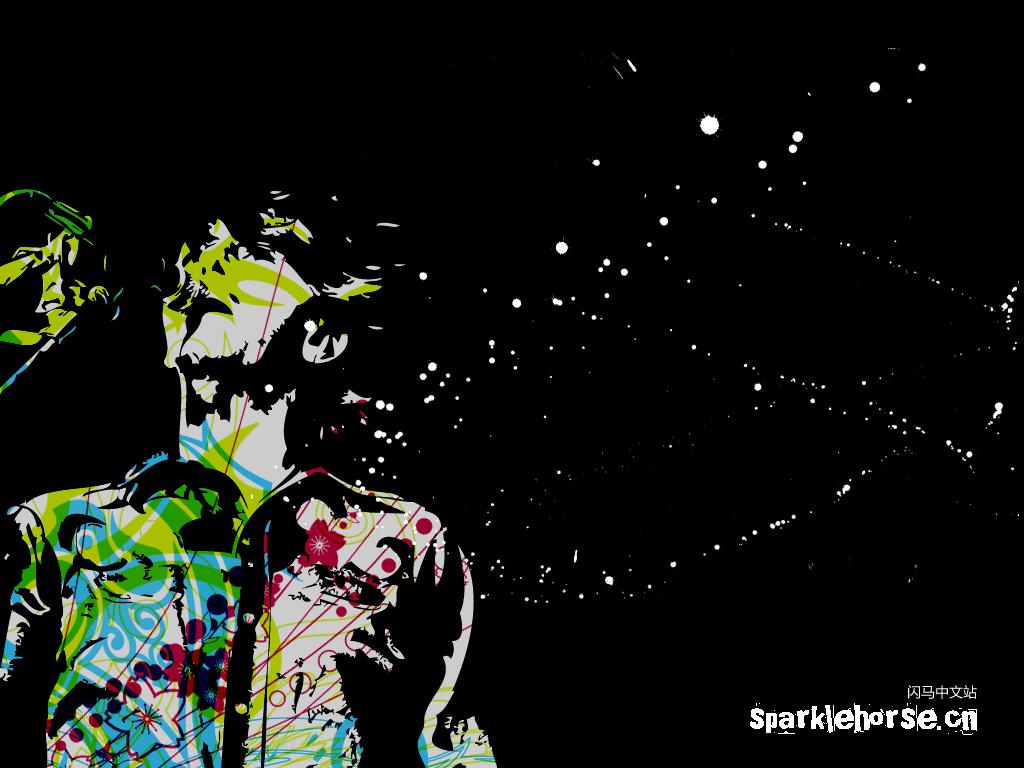NOW PLAYING ON PHAWKER RADIO!
 BY JONATHAN VALANIA HE WAS DEAD ONCE. FOR TWO BREATHLESS MINUTES in 1996, Mark Linkous, the auteur behind Sparklehorse, lay dead on the floor of a London hotel room while paramedics rushed to revive him. Fourteen hours earlier he’d stepped off a plane at Heathrow Airport to begin a European tour supporting Radiohead. After swallowing an ill-advised cocktail of Valium, liquor and prescription antidepressants, Linkous collapsed on his hotel-room floor, where he would lie on his back for the next 14 hours in a kneeling position that cut off the circulation to his legs. When the paramedics finally arrived and untangled him, a massive build-up of potassium in his legs shot to his heart, inducing cardiac arrest. Much like life, death is rarely as it is in the movies. Their was no light at the end of the tunnel of stairway to heaven. There was just…nothing.
BY JONATHAN VALANIA HE WAS DEAD ONCE. FOR TWO BREATHLESS MINUTES in 1996, Mark Linkous, the auteur behind Sparklehorse, lay dead on the floor of a London hotel room while paramedics rushed to revive him. Fourteen hours earlier he’d stepped off a plane at Heathrow Airport to begin a European tour supporting Radiohead. After swallowing an ill-advised cocktail of Valium, liquor and prescription antidepressants, Linkous collapsed on his hotel-room floor, where he would lie on his back for the next 14 hours in a kneeling position that cut off the circulation to his legs. When the paramedics finally arrived and untangled him, a massive build-up of potassium in his legs shot to his heart, inducing cardiac arrest. Much like life, death is rarely as it is in the movies. Their was no light at the end of the tunnel of stairway to heaven. There was just…nothing.
Two days later, Linkous woke up in St. Mary’s Hospital, where the doctors delivered some very good news and some very bad news: He would live, but his legs would probably have to be amputated. Linkous shuddered at the memory and immediately starts rolling another cigarette out of the fine French tobacco. He’s sitting in the darkened lounge of a Richmond, VA., recording studio, where he’s producing a new Daniel Johnston record. Linkous’ voice, much as it is on record, is a raspy whisper, barely rising above the warbling mellotron sounds drifting in the from the next room. He’s pale and frail-looking, and though he’s been working for hours, he looks like he just woke up. He’s dressed head-to-toe in black, which matches his goatee and his thick, inky black tangle of hair.
“Basically, when your limbs get cut off like that, they just lose all their oxygen and start dying, so my legs were basically just dying from here down, ” He says, pointing to his knees. “The doctors were trying everything, pumping me full and antibiotics and morphine. I had tubes going in and out of me all the time.” Linkous lay in St. Mary’s Hospitals for three months, enduring a series of painful procedures to remove dead tissue from the inside of his legs. It wasn’t until the seventh operation that the threat of amputation was lifted. “Thank God I had a work visa, so the hospital bills were covered by [Britain’s health-care system], ” he says. “The bill was probably more than a million dollars. And I didn’t have health insurance.” Linkous spent the next year in a wheelchair, numbed on morphine, before beginning an aggressive physical-therapy regime that eventually restored his ability to walk. He will, however, have to wear braces on his legs for the rest of his life, and though he can walk, he will never run again. Which is a fair enough bargain, because Linkous — like music he makes with Sparklehorse — is in no particular hurry.
basically just dying from here down, ” He says, pointing to his knees. “The doctors were trying everything, pumping me full and antibiotics and morphine. I had tubes going in and out of me all the time.” Linkous lay in St. Mary’s Hospitals for three months, enduring a series of painful procedures to remove dead tissue from the inside of his legs. It wasn’t until the seventh operation that the threat of amputation was lifted. “Thank God I had a work visa, so the hospital bills were covered by [Britain’s health-care system], ” he says. “The bill was probably more than a million dollars. And I didn’t have health insurance.” Linkous spent the next year in a wheelchair, numbed on morphine, before beginning an aggressive physical-therapy regime that eventually restored his ability to walk. He will, however, have to wear braces on his legs for the rest of his life, and though he can walk, he will never run again. Which is a fair enough bargain, because Linkous — like music he makes with Sparklehorse — is in no particular hurry.
This wasn’t always the case. Born “in the early ’60s” in Fairfax, Va., and raised in the southwestern tip of the state that sticks into the side of Kentucky like a thorn, Linkous was in a hurry back then — to grow up, to get the fuck out of Dodge. His father was a coal miner, as was his father’s father, a tough sonovabitch who once punched a mule straight between the eyes and knocked it dead. Linkous went to live with his grandmother after his parents split up and he got too wild for his mother to handle. His grandmother didn’t have much more luck reining him in. Linkous got his first dirt bike when he was eight, and by age 13, he was drinking and raising hell with the Pagans, a bad-ass motorcycle gang.  “I tried to give myself a Led Zeppelin tattoo with a razor blade,” says Linkous, wincing at the memory. “But I bled so much I only got to ‘Led Zep.'” His grandfather bought him his first guitar. After high school, he kicked around Charlottesville, looking for fun and rock n’ roll and finding both in a band called the Dancing Hoods. They moved up to New York to catch the tail end of the CBGB punk scene. “I wanted to wear a leather jacket and be the Buzzcocks or something,” says Linkous. After four years, the Dancing Hoods tired of New York and Moved to Los Angeles in search of glamour and glory. Like all bands that migrate to L.A., their plan was simple: become rock stars. While they did manage to release a couple of Replacements-style albums on the Relativity label, the Big Deal never materialized. When the Dancing Hoods broke up, Linkous found himself living on a van parked on Venice Beach, bitter, disillusioned and strung out on heroin. “I was just ready to walk out into the Pacific.”
“I tried to give myself a Led Zeppelin tattoo with a razor blade,” says Linkous, wincing at the memory. “But I bled so much I only got to ‘Led Zep.'” His grandfather bought him his first guitar. After high school, he kicked around Charlottesville, looking for fun and rock n’ roll and finding both in a band called the Dancing Hoods. They moved up to New York to catch the tail end of the CBGB punk scene. “I wanted to wear a leather jacket and be the Buzzcocks or something,” says Linkous. After four years, the Dancing Hoods tired of New York and Moved to Los Angeles in search of glamour and glory. Like all bands that migrate to L.A., their plan was simple: become rock stars. While they did manage to release a couple of Replacements-style albums on the Relativity label, the Big Deal never materialized. When the Dancing Hoods broke up, Linkous found himself living on a van parked on Venice Beach, bitter, disillusioned and strung out on heroin. “I was just ready to walk out into the Pacific.”
Then he heard Tom Waits guest DJing on KCRW, a celebrated beacon of adventurous programming. Waits was playing all of his old-timey music: quaint, rustic sounds that were as far away from the glam-metal grind of L.A., as Linkous was from his native Virginia. He called his mom the next day and told her he wanted to come home and check into rehab.
LIKE MANY YOUNG MEN WHO SET OUT TO CONQUER the world, Linkous would abandon it altogether. After getting clean, Linkous moved into an old farmhouse in Bremo Bluff, a dot on the map located an hour west of Richmond. Like nearby Enon, where he now lives in yet another gloriously quaint farmhouse, Bremo Bluff is one of those places everyone knows is nowhere. Perfect, Linkous thought. He started making music again, but it was much different then the revved-up rock n’ roll music of the Dancing Hoods. He fell in with a bunch of local musicians who would sit around each other’s living rooms, playing mountain music and old Irish folk tunes on acoustic instruments. “The songs would end and drift off into air,” recalls Linkous. “There was no need to record them. They had already served their purpose.”
Inspired by folk artists like Howard Finster and the spectral Americana of novelist Cormac McCarthy, Linkous began tapping into the rural reveries of his youth. “I would take trips back to that part of Virginia and have all these memories about spending all my time in the woods and the mountains,” he says. It’s a whole different atmosphere down there, all dark hallows. The terrain is real severe, lots of steep mountains. If you drive off the road, you’ll drive off the side of the mountain.”
Emboldened by Waits’ arty hobo music and the early homemade cassettes of Johnston, Linkous began fashioning songs that drew from his backwoods roots and the romance and mystery of the South. Sad-eyed, rustic and surreal, they formed the basis for a project he began referring to, evocatively enough, asSpaklehorse . Linkous set up and eight-track recorder near a shack near his house and christened it Static King. It was here he fashioned the first Sparklehorse album, 1995’s vivadixiesubmarinetransmissionplot. The record’s title was inspired by a dream he had about one submarine the Confederacy had during the Civil War. “I was swimming in a river and the submarine shows up, and as I swam towards it, I could hear this old-timey, string-band music, like they were playing inside of it,” he says. So I used that for the title.”
Vivadixie is an auspicious debut. Its music is suffused with desolate beauty, antiqued production and a spooky aura of ghostly Americana; imagine the melodious wheezing of Niel Young on a ventilator. The album made the rounds of A&R offices at all the major labels before landing on the right desk at Capitol, which eventually released it. Vivadixie attracted glowing reviews but little in the way of commercial radio plays or sales. Still, Radiohead loved the album and asked Sparklehorse to join the band on tour in Europe. Linkous got on a plane to London. He would be dead then less than 24 hours.
ONE OF THE BEST THING ABOUT BEING DEAD IS they give you drugs when you wake up. “In a way, it was the best time of my life, just being in a wheelchair and being on morphine all the time,” says Linkous, recalling the months he spent recovering from the agonizing surgeries. “I probably would have blown my head off without it.” He did a tour like that–wheelchair-bound and comfortably numb. “It was kind of pathetic,” he says. “I wasn’t playing very well.”
was the best time of my life, just being in a wheelchair and being on morphine all the time,” says Linkous, recalling the months he spent recovering from the agonizing surgeries. “I probably would have blown my head off without it.” He did a tour like that–wheelchair-bound and comfortably numb. “It was kind of pathetic,” he says. “I wasn’t playing very well.”
The physical rehabilitation was long and painful. It would be a year before he’d be able to get up out of that wheelchair, which gave him plenty of time to work on songs for the next Sparklehorse album, 1998’s Good Morning Spider. The title suggests one of those harrowing solitary-confinement scenes with the hollow-eyed prisoner lying in a fetal position in the dark, so lonely and detached that his only visitors are those small enough to scuttle under the crack of the cell door. It wasn’t exactly the feel-good album of the year. “Blanket me, sweet nurse, and keep me from burning,” Linkous intones over a fever-dream folk strum of “St. Mary,” massaging the sad heart of his horse-whispered melodies back to life.
Much like Sparklehorse’s debut, Good Morning Spider opened to great reviews and negligible sales, which was at once flattering and frustrating. Still, the album did attract some high-profile admirers like Waits and Polly Jean Harvey. Both would appear on the next Sparklehorse album, the recent It’s a Wonderful Life.
“I like Sparklehorse a lot,” Waits told MAGNET in 1999. “Somebody asked what I thought about them, and I said, ‘You know, it’s like if you open your eyes at the bottom of a stream, stuff floating by, algae, a carp, wet rocks.’ Talked to [Linkous] on the phone a couple of times.”
“He called and left a message with his phone number,” remembers Linkous. “I was so nervous I had to lock myself in a room with a bottle of whiskey before I could call him back.”
Linkous and Waits agreed to collaborate on a song via the mail. Linkous would lay down ideas on a four-track recorder and send the four-track to Waits, who would then add to the song and send it back. “Eventually, the four-track got destroyed in the mail,” says Linkous. When he began working on It’s a Wonderful Life, Linkous decided to try the in person approach. He had the basis for a song he thought would be perfect for Waits. “It was this kind of menacing, Portishead thing,
*
“IN A WAY, IT WAS THE BEST TIME OF MY LIFE, JUST BEING IN A WHEELCHAIR AND BEING ON MORPHINE ALL THE TIME.”
*
but I couldn’t come up with words or a melody for it,” says Linkous, referring to the Captain Beefheart trip hop of “Dog Door.” “I sent it to Tom, who called back and said, ‘I think I have something for it.’ So I flew out to California. I remember he drove up to the studio with his truck full of all these great, weird noisemakers. He did a couple of vocal takes. ‘How was that, Mark?’ And I was like [adopts kid-in-a-candy-store voice], “Um, would it be OK if you tried it once with the megaphone?’ ‘Sure, Mark.’ And then he put that little train whistle on it.”
At this point, Linkous excuses himself to get back to work on the Johnston album. It’s a labor of love that, like his collaboration with Waits, represents the completion of a circle of inspiration that’s been arcing for nearly 10 years. All things considered, these are better days for Linkous, after so many seasons in hell. While he still can’t understand why he can go to Australia and hear Smog playing in grocery stores but Sparklehorse can’t get arrested on American radio, or why 6,000 people at an outdoor festival in Belgium will sing along to every word of “Homecoming Queen” but at home his records sell only in the thousands, he’s thankful for what he’s got.
Linkous is, as they say, a prestige artist, bringing a major label some artsy cred amid all the crass commercialism. As such, he’s afforded certain dignities. Capitol and the Sundance channel bankrolled a series of short films for It’s a Wonderful Life by high-profile indie directors including Guy Maddin (Careful), Danny Clinch (Ben Harper’s Pleasure and Pain), Braden King (Dutch Harbor), Grant Gee (Radiohead’s Meeting People is Easy) and Jem Cohen (Fugazi’s Instrument). The films were compiled into an hour-long installment of Sundance’s Sonic Cinema. And Linkous is allowed to continue making albums solely on the strength of the glowing reviews hey garner. He has his dogs and his seven motorcycles and his wife, Teresa, and his farmhouse in the middle of nowhere. By most people’s standards, this is a wonderful life — which is a lot more than Linkous had for two minutes back in 1996.
“Just one more thing,” he says over his shoulder as he walks back into the control room. “When you write about the heroin stuff, please don’t make it sound cool. I would hate for some kid to read that and get the wrong idea.”
